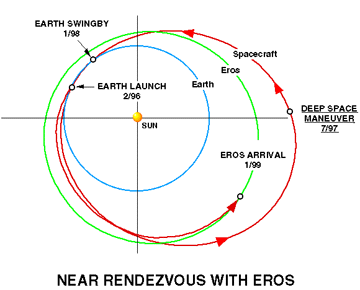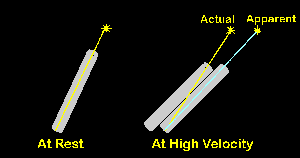
Lost in Space: Can You Get Lost In Space? The Scientific View
by Peter Backus

|
NASAís successes in the exploration of our Solar System have been impressive. The recent close passage of the NEAR spacecraft to the Earth illustrates the state-of-the-art in interplanetary navigation skills. In order to place NEAR into an orbit that will bring it close to the asteroid Eros, it was launched into an orbit that brought it back toward the Earth. The motion of the spacecraft has to be precisely aimed so that it picks up a boost in velocity and change in direction due to the motion of the Earth.
 NASA can perform such billiard shots with incredible accuracy because the positions and velocities of the Earth, the spacecraft and, to some extent, the asteroid are known with high precision. The relative positions of the Earth and asteroid are measured with radar and astrometry techniques. The position and velocity of the NEAR spacecraft is measured to high accuracy by tracking the frequency and phase of a signal transmitted from the spacecraft. The frequency changes due to the Doppler Effect caused by the changing velocity of the spacecraft in its orbit. The phase, i.e., the alignment of the radio waves of the spacecraft signal compared to a standard signal on the Earth, can be used to measure the distance to the spacecraft with high accuracy.
NASA can perform such billiard shots with incredible accuracy because the positions and velocities of the Earth, the spacecraft and, to some extent, the asteroid are known with high precision. The relative positions of the Earth and asteroid are measured with radar and astrometry techniques. The position and velocity of the NEAR spacecraft is measured to high accuracy by tracking the frequency and phase of a signal transmitted from the spacecraft. The frequency changes due to the Doppler Effect caused by the changing velocity of the spacecraft in its orbit. The phase, i.e., the alignment of the radio waves of the spacecraft signal compared to a standard signal on the Earth, can be used to measure the distance to the spacecraft with high accuracy.
NASA makes navigating the Solar System seem pretty easy. Compared to navigating among the stars, it is. The distances involved are, after all, astronomical. On the scale of the Earthís orbit depicted above, the Alpha Centauri star system would be about 4.5 km away. Traveling the actual distance of 4.2 light years (40,000,000,000,000 km), with current technology, or technology likely to be available in the foreseeable future, means that the trip will take a long time. This is both good news and bad. The bad news is that the trip will require more than a human lifetime (making it indeed a multigenerational family trip). The good news is that the navigators will be able to use straightforward, non-relativistic physics and mathematics. For navigating at non-relativistic velocities the navigator will need the equivalent of the mariner's sextant and star tables. This means the ship must be equipped with a precision astrometric telescope and a star database with accurate positions, distances and intrinsic velocities for a large sample of nearby stars.
 As the ship travels in space, the apparent positions of the nearest stars would gradually change with respect to the more distant stars. (You can see this parallax effect by holding your index finger in front of your face and alternately looking at it with each eye. The position of your finger will seem to shift against the background.) The navigator could make periodic measurements of the apparent positions of the nearby stars, and using trigonometry, solve for the position and velocity of the ship.
As the ship travels in space, the apparent positions of the nearest stars would gradually change with respect to the more distant stars. (You can see this parallax effect by holding your index finger in front of your face and alternately looking at it with each eye. The position of your finger will seem to shift against the background.) The navigator could make periodic measurements of the apparent positions of the nearby stars, and using trigonometry, solve for the position and velocity of the ship.
An alternate approach might use a radio telescope with pulsars serving as navigational beacons. Each pulsar has a unique pulse period, average pulse shape, and rate of change of its pulse period. By monitoring the precise time of arrival of pulses from a sample of pulsars, the navigator could again solve for the position of the ship. This scheme was used on the plaques attached to the Pioneer 10 and 11 spacecraft to indicate the position of the Solar System for any interstellar travelers encountering our first interstellar spacecraft.
 The radiating lines in the left portion of the plaque represent the relative positions and distances to about a dozen nearby pulsars. A number along each line indicates the pulse period for that pulsar at the time of the launch of the spacecraft.
The radiating lines in the left portion of the plaque represent the relative positions and distances to about a dozen nearby pulsars. A number along each line indicates the pulse period for that pulsar at the time of the launch of the spacecraft.
Using pulsars for navigation would be somewhat ironic. When they were first discovered in 1968, it was suggested that pulsars might be interstellar navigation beacons set up by an extraterrestrial civilization. During the initial excitement, and before they were identified as neutron stars, the first two pulsars were referred to as LGM1 and LGM2, where LGM stood for Little Green Men.
If we ever make a breakthrough that allows travel at a significant fraction of the speed of light, the trip to Alpha Centauri will take less than a human lifetime, but the job of the navigator is trickier. The apparent positions and colors of the stars are distorted. Looking aft, the Sun would appear as a fading red dot. In our forward view screen, our destination star would appear blue-white. In reality, the Sun and Alpha Centauri A are nearly identical in color. The changes are caused by the Doppler effect. Familiar in everyday life for the changing pitch of a moving sound, e.g., the siren of a police car, it applies to all wave phenomena including light. It just takes very high velocities to make the effect on light perceptible to the eye. Since the ship is moving away from the Sun, its light is seen at a lower "pitch", i.e., it is shifted toward the lower frequency red portion of the spectrum. The light from Alpha Centauri is shifted higher in "pitch" to the blue end of the spectrum.
 The apparent positions of the stars not along the direction of motion are distorted by an effect called aberration. At high speed, the telescope may travel more than its own width in the time that it takes light to travel down the tube. Thus the tube of the telescope must be tilted in the direction of travel so that the light from the star will not hit the side of the tube. The position of the star appears to shift in the direction of movement. This effect becomes more pronounced at higher velocities, complicating the life of the interstellar navigator.
The apparent positions of the stars not along the direction of motion are distorted by an effect called aberration. At high speed, the telescope may travel more than its own width in the time that it takes light to travel down the tube. Thus the tube of the telescope must be tilted in the direction of travel so that the light from the star will not hit the side of the tube. The position of the star appears to shift in the direction of movement. This effect becomes more pronounced at higher velocities, complicating the life of the interstellar navigator.
At higher velocities, the effects of relativity become even more pronounced. The navigator might have to rely on precise measurements of all accelerations and very accurate shipboard time keeping.
However, at whatever speed you travel, don't bring along a Dr. Smith!
Suggestions? Comments? Fill out our Feedback Form.